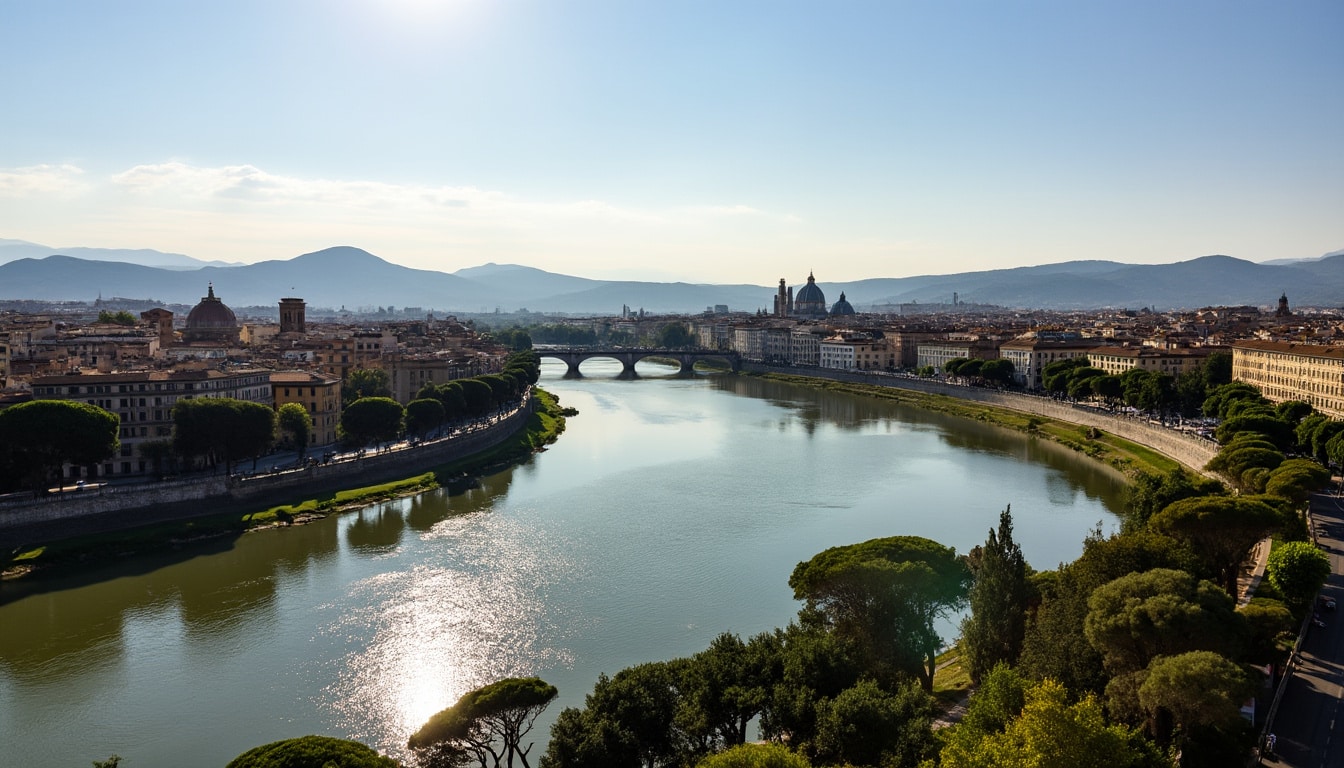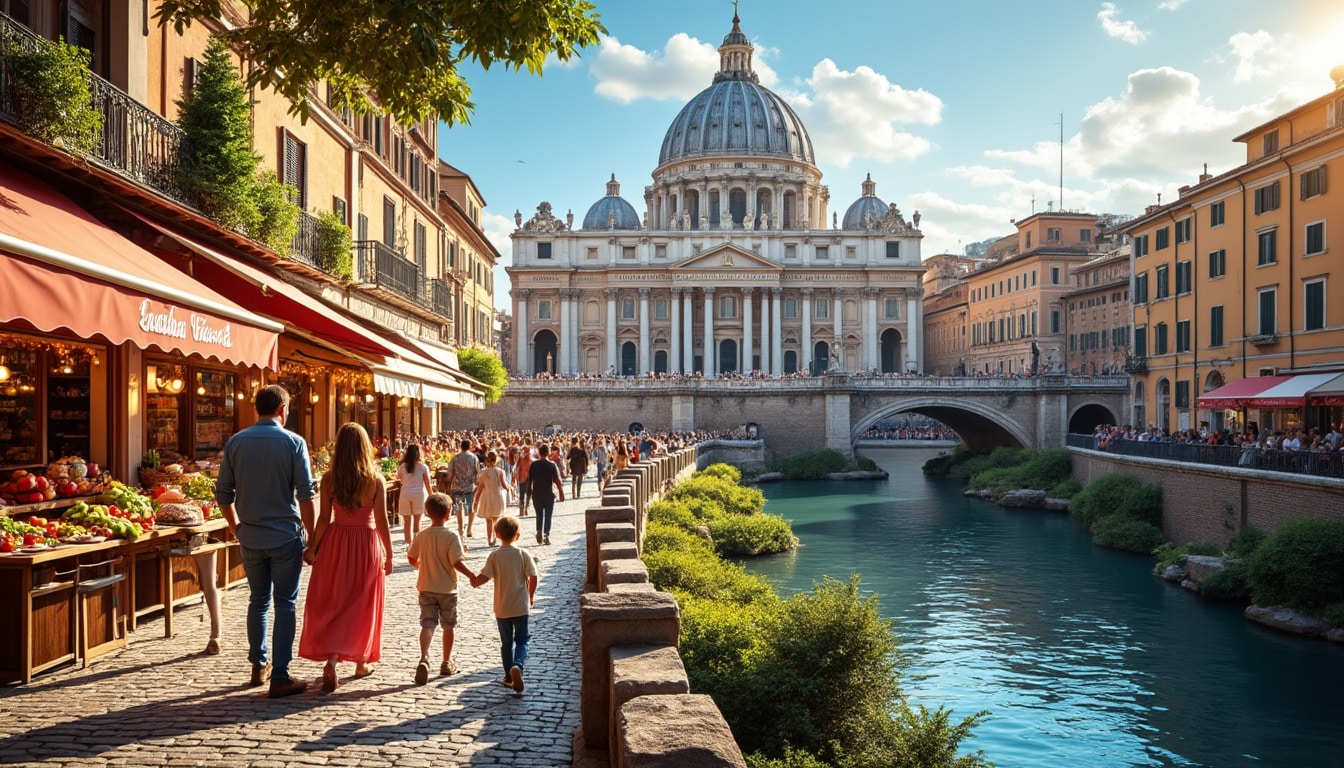Rome is a city that effortlessly marries the grandeur of its past with the vibrancy of the present. As Italy’s capital, it stands as a testament to a rich history, enshrined in its cobblestone streets, legendary ruins, and breathtaking art. However, beyond its monumental attractions, Rome’s geography and demographics play a critical role in defining the essence of this eternal city. With a population that teeters near 3 million within the city limits and expands to over 4 million in its metropolitan area, Rome embodies a dynamic blend of ancient heritage and diverse modernity. From the enduring flow of the Tiber River to its iconic seven hills, and from bustling markets to serene piazzas, Rome invites exploration into its layered geography and vibrant demographic tapestry.
Geographical Significance of Rome’s Location
Perched in the central-western region of Italy, Rome’s geographical setting extends beyond mere cartographic significance. It occupies the heart of the Lazio region, famously draped along the Tiber River, which has been a silent witness to the city’s transformation over millennia. This eternal river slices through the city, serving as more than a natural feature; it is a lifeline, an ancient artery that has sustained trade, life, and legends.
The city is famously established upon its seven hills – Palatine, Aventine, Capitoline, Esquiline, Quirinal, Viminal, and Caelian. These hills are not mere landforms but are landmarks shaped by history and mythologies. Each hill narrates its own chapter of Roman chronicles, from the political epicenter on the Capitoline to the imperial grandeur of the Palatine.
Accentuating Rome’s geographical intrigue is its unique status as an enclave of an independent state—Vatican City. This sovereign entity nests within the bosom of Rome, infusing it with a paradoxical charm as both a bustling city and a center of ecclesiastical power.

The city’s topography further enhances its allure with scenic avenues and lush villas sprawled across its landscape. Such a setting provides a backdrop not only for the wonder of ancient structures but also for cultural experiences that delight both residents and visitors alike. The geographical layout contributes to the city’s intricate network of pathways, ensuring that each discovery of historical tours or local markets adds to the richness of Rome’s culinary and cultural tapestry.
The Tiber River: Rome’s Lifeblood
The Tiber River serves as a pivotal element in Rome’s geographical narrative. Running approximately 405 kilometers, it weaves through central Italy before emptying into the Tyrrhenian Sea. Historically, the river provided access to the vast Mediterranean world, fostering economic and cultural exchanges that were vital to ancient Roman ascendancy.
- 🌊 Source of sustenance: The Tiber’s waters historically supported agriculture, paving the way for the bountiful Italian cuisine enjoyed today.
- 🚢 Channel of trade: It acted as a conduit for goods and people, facilitating the rich influx of diverse cultures and crafts into Rome.
- 🚶 Paths of leisure: Modern Rome embraces the riverbanks with promenades and vibrant cultural experiences, offering a refreshing contrast to the city’s urban sprawl.
The Tiber’s enduring presence symbolizes the seamless blending of past and present, much like the demographics of Rome itself, where ancient origins harmoniously coexist with dynamic modernity.
Demographic Diversity in Modern Rome
In the lively heart of Italy, Rome’s demographic landscape is as diverse and captivating as its historical features. With a resident population rising to nearly 3 million, the city exudes vibrancy from every corner, underscored by an eclectic mix of locals, expatriates, and tourists. Rome is not just a testament to human endurance and creativity; it is a thriving amalgamation of stories, lifestyles, and cultures.
As Italy’s most populous commune, and the third within city-limits population in the European Union, Rome is home to a melting pot of ethnicities and cultures, reflecting a legacy of diverse influx since the days of the Roman Empire. This blend creates a dynamic that manifests through diverse culinary offerings, bustling markets, and vibrant neighborhood communities.
The city’s demographic evolution mirrors its societal changes, where historical depth enriches modern narratives. Rome stands as a vivid example of Italy’s broader immigration trends, with waves of individuals bringing vibrancy and variety. Notably, younger demographics lead the city’s modern evolution, instilling fresh energy into neighborhoods and ushering in novel cultural experiences.
Rome’s Cultural and Social Fabric
Demographics in Rome are an indicator of cultural dynamics at play. The population is designed by a multiplicity of factors, including:
- 👨👩👧👦 Varied generations: From young entrepreneurs to cultural custodians ensuring historical tours preserve their heritage.
- 🍝 Gastronomic variety: An array of Italian cuisine from various regions, complemented by international flavors brought by immigrant communities.
- 🌍 Seasonal influx: The booming tourism industry consistently welcomes visitors exploring the rich tapestry of Roman artifacts and heritage sites.
Such facets create a mosaic that shapes Rome’s hospitality and gives life to its Rome tourism industry, making it an international epicenter for heritage seekers and culture enthusiasts.
Historic Neighborhoods and Their Modern Influence
Rome’s neighborhoods are rich in history and vibrancy, each presenting a unique narrative fueled by its past and current transformations. These areas personify a modern integration of historical landmarks and contemporary living, providing both historical tours and present-day Rome accommodation options.
The historic center, known for its masterpieces like the Colosseum and Trevi Fountain, remains a magnet for visitors globally. It stands as the cultural hub of Roman artifacts, seamlessly integrating ancient traditions with present-day lifestyle.
- 🏛️ Centro Storico: A UNESCO world heritage site, rich with history, simultaneously hosting some of the finest cultural experiences and local markets.
- 🍷 Trastevere: Famed for its authentic Roman cuisine and lively streets, offers a dive into Italy’s quintessential sociocultural dining.
- 🛍️ Monti: Known for its quaint boutiques and vibrant street life, this area offers insights into Rome’s fashionable edge.
Rome’s neighborhoods continue to adapt while remaining deeply connected to their historical roots, presenting a harmonious blend of old world charm and modern vitality.
This interplay between historic marvels and contemporary pulse exemplifies the city’s ongoing renaissance and fuels its vibrant urban landscape.
Neighborhoods as Cultural Beacons
The various Roman neighborhoods serve as cultural beacons, each offering unique experiences:
- ☕ Cozy cafes in Monti: Perfect for leisurely afternoons.
- 🍽️ Dining in Testaccio: Celebrated for its market-fresh cuisine.
- 🎨 Artisans in Pigneto: A hub for emerging artists and cultural exchanges.
Such facets ensure that every visitor finds a piece of Rome that resonates personally, fostering a deep connection with the city.
Rome’s Urban Growth and Development
The story of Rome’s evolution from ancient settlements to a sprawling metropolis is one of strategic urban planning and adaptation. As the city continues to navigate the demands of modern growth, maintaining balance with its historical silhouette remains paramount.
Rome’s expansion involves a mix of preserving historical integrity while accommodating contemporary urban demands. The city’s infrastructural strategies aim to blend its rich past with innovative solutions for housing, transportation services, and public spaces.
Infrastructure: Bridging Past and Future
Recent developments not only serve the growing populace but also respect the city’s architectural legacy:
- 🚇 Efficient transportation services: Improved metro lines enhance accessibility across Rome.
- 🏢 Sustainable housing solutions: New projects incorporate eco-friendly designs to harmonize with heritage sites.
- 🌿 Public spaces initiatives: Creating green zones to provide calm amidst urban bustle.
These infrastructural developments ensure the city remains viable for future residents while honoring its role as a guardian of cultural legacy.
| Urban Feature | Description | Impact |
|---|---|---|
| Transportation | Expanded metro lines and modern buses | Improved city connectivity |
| Housing | Sustainable and eco-friendly designs | Environment-focused urban living |
| Public Spaces | New parks and recreational areas | Enhanced community well-being |
In these ways, Rome’s urban narrative continues to unfold, bridging its storied history with a future filled with possibilities.
FAQs on Demographics and Geography of Rome
Here’s a comprehensive FAQ section that covers some of the common inquiries related to the demographics and geography of Rome:
- What is the population of Rome? In 2025, Rome boasts a population of around 3 million within city limits and over 4 million in the metropolitan area.
- What geographical features define Rome? Rome is defined by its historical seven hills, the Tiber River, and the unique enclave of Vatican City within its boundaries.
- How diverse is Rome’s demographic? Rome is a rich tapestry of cultural diversity, home to a dynamic blend of locals and expatriates that cultivate a vibrant urban culture.
- How has Rome’s infrastructure adapted to urban pressures? Infrastructure developments include extended metro lines, eco-friendly housing, and increased public green spaces to accommodate its growing population.
- What neighborhoods are notable for cultural exploration? Neighbourhoods such as Trastevere for authentic Roman cuisine, Monti for fashion, and Pigneto for artistry offer rich cultural experiences.

